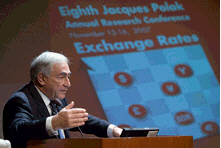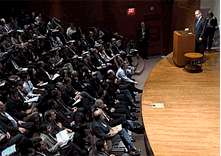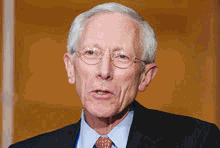
Typical street scene in Santa Ana, El Salvador. (Photo: iStock)
IMF Survey: IMF Sharpens Exchange Rate Views at Research Conference
November 21, 2007
The IMF put the spotlight on exchange rates at its annual research conference, held in mid-November at a time of continued concern about currency market fluctuations and exchange rate misalignments.

Effective surveillance requires tools for assessing consistency of exchange rates with medium-run fundamentals (photo: Toshiyuki Aizawa/Reuters)
2007 IMF research conference
A group of leading economists met for the IMF's eighth Jacques Polak Annual Research Conference in Washington D.C. to present papers on and discuss a wide range of exchange rate-related issues. Topics covered at the conference, which was opened by new IMF Managing Director Dominique Strauss-Kahn, included the international role of the dollar, unbalanced trade, exchange rate models, and when to abandon a fixed exchange rate.
The keynote Mundell-Fleming Lecture on "Exchange Rate Systems, Surveillance, and Advice" was delivered by Stanley Fischer, Governor of the Bank of Israel and former IMF First Deputy Managing Director. Peter Garber from Deutsche Bank, Michael Mussa from the Peterson Institute of International Economics, and David Wessel from the Wall Street Journal participated in an Economic Forum on "The Exchange Rate and Economic Performance," which was moderated by Simon Johnson, the IMF's Economic Counsellor and Head of the Research Department.
The conference marks the 70th year of Jacques Polak's career as an international economist. At the conference, both Strauss-Kahn and First Deputy Managing Director John Lipsky paid warm tributes to Polak, acknowledging his important role in shaping the work of the IMF.
Increasing interdependence
In his opening remarks, Strauss-Kahn singled out three exchange rate-related themes—increasing macroeconomic interdependence stemming from globalization; exchange rate determination; and political economy perspectives on exchange rates—that were highlighted at the conference. On the first theme—the implications of increasing interdependence—he cited the paper "Macroeconomic Interdependence and the International Role of the Dollar," by Linda Goldberg and Cedric Tille, in which the authors argue that U.S. or European Central Bank monetary policy can have far-reaching effects on countries that denominate trade in dollars, even if direct trade with the United States or the euro area is negligible. "This is especially important for the dollar and the euro," Strauss-Kahn said.

DSK: effective surveillance allows that overvaluations in some places be balanced by undervaluations elsewhere (IMF photo)
The interaction between exchange rates and goods trade between countries is central in analyzing cross-country interdependence and policy spillovers. In their paper on fiscal policy and the trade balance, Tommaso Monacelli and Roberto Perotti of the Università Bocconi underscored the importance of fiscal policy for the real exchange rate and the trade balance. They found that, in all OECD countries that were part of their sample, a rise in government spending induces a real exchange rate depreciation and a trade balance deficit. In the United States, however, the trade balance effect is small.
On the degree of real exchange rate adjustment necessary to improve the U.S. current account balance—a topic of continuing debate—Robert Dekle, Jonathan Eaton, and Samuel Kortum calibrated a novel trade model and found that balancing current accounts may require modest changes in relative wages and real wages. For example, wages in the United States (country with the largest deficit) need to fall by around 10 percent relative to those in Japan (country with the largest surplus) to balance current accounts.
Exchange rate determination
The issue of how exchange rates are determined over time, Strauss-Kahn said, was of the "highest importance" for the Fund. Referring to the IMF's 2007 Decision on Bilateral Surveillance—which provides a comprehensive framework for monitoring country economies anchored on the concept of external stability— Strauss-Kahn stressed that effective surveillance would require not only an appreciation of a member's individual circumstances, but also solid analytical tools for assessing the consistency of exchange rates with medium-run fundamentals. Such tools take into account the constraint that overvaluations in some parts of the world need to be balanced out by undervaluations elsewhere—or multilateral consistency.
In this context, Strauss-Kahn underscored the work of the Fund's Consultative Group on Exchange Rates (CGER), which had been expanded to include the key emerging market countries as well as the main currencies in the industrial world.
Lipsky described the CGER as a cutting-edge analytical tool for conducting bilateral and multilateral surveillance in an evenhanded fashion. He said the scope of the Fund's analytical work on exchange rates would expand further—to include producers of exhaustible natural resources and some low-income countries that have become important players in the global economy. Progress is also being made on integrating portfolio investment decisions into the CGER framework.

Lipsky: scope of IMF exchange rate work to include exhaustible natural resource producers, important low-income countries (IMF photo)
In the first paper presented in the exchange rate determination session, "Financial Exchange Rates and International Currency Exposures," Philip Lane and Jay C. Shambaugh highlight how the foreign-currency denomination of a country's external position can play a pivotal role in external adjustments.
Several papers in the conference also considered the impact of economic fundamentals and policy on the exchange rate. Columbia University's Richard Clarida and Daniel Waldman examined the impact of monetary policy on the exchange rate, arguing that news of higher-than-expected inflation can lead to an appreciation of the nominal exchange rate if the central bank has an inflation target implemented with a "Taylor Rule."
Charles Engel, Nelson C. Mark, and Kenneth D. West found in their paper, "Exchange Rate Models Are Not as Bad as You Think," that when flexible exchange rates incorporate news about future macroeconomic fundamentals, as implied in standard models, these models should be expected to have low forecasting power and thus should not be subject to the standard critiques of the literature. The authors proposed a number of ways to evaluate models and showed that these models might be able to account for observed exchange rate volatility.
Political economy
The political constraints faced by country authorities in making economic policy decisions are well known. Two conference papers focused on how the preferences of different interest groups over exchange rate movements may play out in practice.

Fischer: delivered keynote Mundell-Fleming Lecture on "Exchange Rate Systems, Surveillance, and Advice" (IMF photo)
In their paper on exchange rate policy attitudes, Lawrence Broz, Jeffry Frieden, and Stephen Weymouth used survey data to show that decisions made by different players in the private sector can hinge on exchange rate movements. Citing this paper as one that highlights the theme of political economy, Strauss-Kahn said this research could be applied to explain why it is that countries often resist pressures both toward currency depreciation and appreciation.
Irineu de Carvalho Filho and Marcos Chamon from the IMF explored the "distributional impact of exchange rate movements" in their paper on the political economy of exchange rate populism. Their research showed that, in Brazil and Mexico, effects of currency appreciations on consumer goods prices tend to benefit poor households more than richer ones. However, the income of the rural poor is more adversely affected when a currency appreciates.
Policy issues
Two conference papers focused on policy responses when the economy is hit by unexpected shocks, paying particular attention to the reaction of the exchange rate. MIT's Ricardo J. Caballero and Guido Lorenzoni explained foreign exchange interventions in countries experiencing capital inflows and persistent real exchange rate appreciations. According to them, intervention in the foreign exchange market has a role to play when there are risks of overshooting and when the export sector is financially constrained.
Sergio Rebelo and Carlos Végh, who studied optimal exit strategies from pegged exchange rate regimes following an unexpected increase in government spending, showed that, when fiscal shocks are large, countries should abandon a peg as soon as possible, even if international reserves are plentiful.
On the issue of the exchange rate regime, Adolfo Barajas, Lennart Erickson, and Roberto Steiner examined why emerging markets fear declaring their exchange rate regime choice. In their paper, "Fear of Declaring: Do Markets Care What Countries Say About Their Exchange Rate Policies," the authors suggested that international capital markets tend to reward countries with exchange rate regimes classified as flexible. And in their paper on estimating de facto exchange rate regimes, Jeffrey Frankel and Shang-Jin Wei developed a new technique for estimating the de facto degree of exchange rate flexibility of a currency.


